hear it here: https://kenbeck.bandcamp.com/album/the-hunt-of-the-unicorn
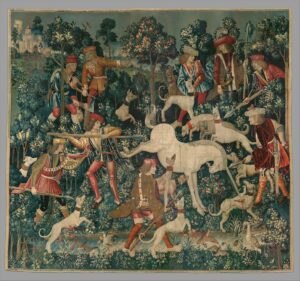
It’s MUCH easier to write about The Hunt of the Unicorn (1979, 1983) than it is about Huckleberry Finn! I can be more objective, since it was my first score made at the direction of a choreographer, rather than the much rarer other way around. Reviewing this piece now; listening to the tapes, looking at the scores, looking at the notes, reading the reviews… it occurs to me that back in the day, one couldn’t just Google somthing and get all the info one would ever want. We were not able to bop over to the Cloisters and bask in the aura of the tapestries. I saw pictures in a book, at best. It was not a book I owned. I was not particularly interested in studying the art. I wanted to get the score made, and was confident at once that I had the idea. Now, looking at the tapestries at various websites, I can see easily what I missed. Also, I can see what I got right.
The Hunt of the Unicorn was begun in 1978, if not earlier. My preference for preceding with these notes is that I query Randall Barron about the history of the piece, memories of it, and also current takes on the material. That might slow me down a bit, and I’ll be inserting Randy’s comments along the way, and in future updates. I have my journals as source materials, in addition to a folder of budget notes, two scores, photo copies of scores, and at least four reels of magnetic tape. The seven inch spools, which are rehearsal recordings, performance masters, and copies of the masters, are all playable. There is another 10 1/2 inch NAB spool of Ampex 1/2 inch tape which is, I presume, the 1983 multitrack master, might be playable, but I don’t have access to a 1/2 inch transport at the moment. Since the master mixes play, I can safely assume I don’t need access to the individual tracks. I’ll address these sources as I go, and that includes the articles and reviews in the Kansas City Times newspaper, all by Harry Haskell.
The first reference I find relevant to Unicorns in my journal is oblique. In June 28, 1977, having hiked on the AT to, and taken the train from Pawling, New York, into New York City, and having hung out in the “New York Nest” at 245 W 51st St., I was at the Cloisters Museum, where the Unicorn Tapestries hang. My entry on this date does not say a word about the tapestries. It, instead, describes my inquiry of Randy (Ran, Randall) about joining the planned move to Sioux City. I wrote, “I asked if there might be room in the prairie schooner for a fourth party. The party was Randy, the Zoon (long, irrelevant story), and Roy Raymond Campfield III, aka “Chip.” Ran’s response, shooting from the hip, is ‘that could probably be arranged.’ The entry ends with a note that the evening was spent ‘going over the by-laws and contract of, and with, the Siouxland Civic Dance Association. They were, I assume, looking for loopholes. In the next entry, written with purple sharpie on the train back to Boston, I have already moved on to planning the move and feelings of nostalgia for the end of life in that city. On August 8th, 1977, I was back in NYC. I reported that me and Chip left Boston at 10:31 that morning.
For a good year or so, the collaboration with Randy that was bashed about was a ‘Native American’ themed idea we called Spirit of the Waters. This idea crops up in list after list. On August 12th, 1978, now with all involved assembled again loosely in Kansas City, Missouri, I wrote the following in my journal…
Randy’s ballet idea:
- The unicorn is seen by the hunters.
- The unicorn at the fountain.
- The unicorn tries to escape.
- The unicorn defends herself. (italics mine.)
- The betrayal of the unicorn by the maiden.
- The capture.
- The unicorn in captivity.
Instrumentation:
- flute
- piano
- clarinet
- percussion
I go on to jot down an outline:
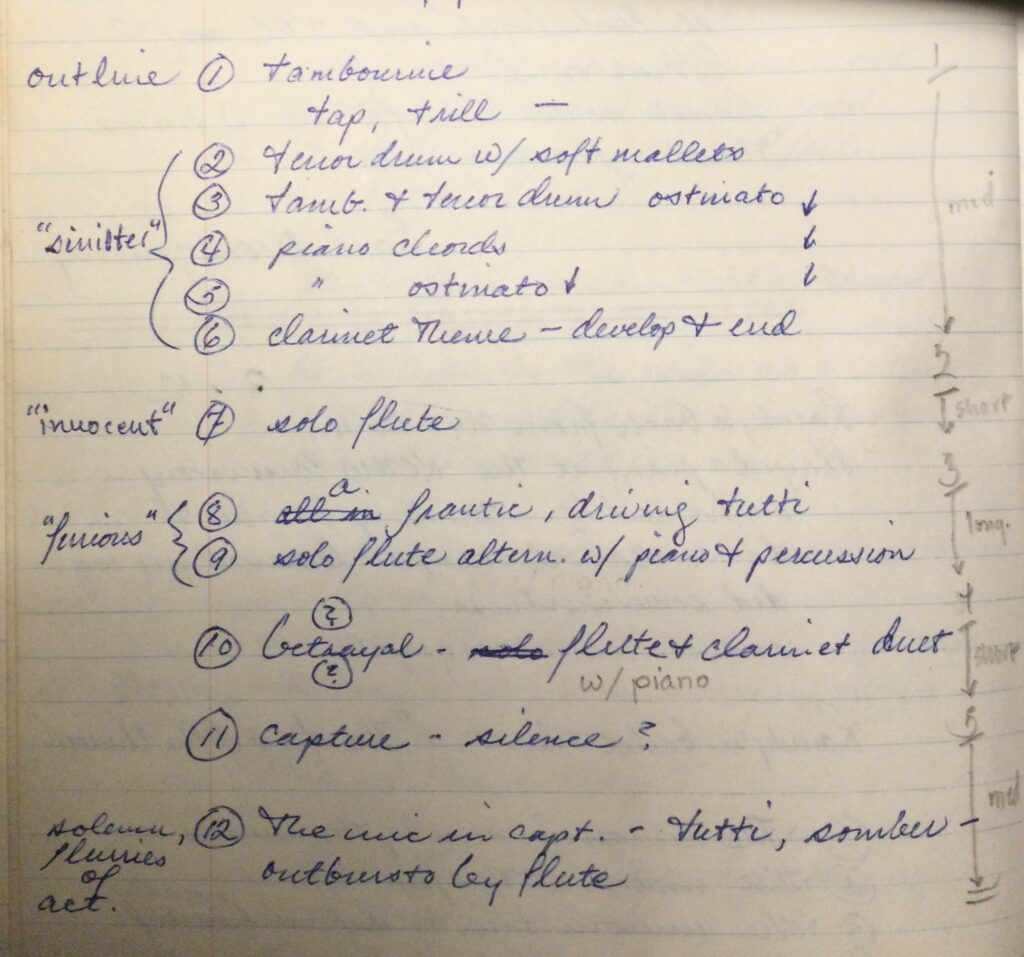
It’s interesting to compare the outline to what eventually made it onto the manuscript paper.
By the 24th of September, I write that ‘I have got a good 4 page beginning on “Unicorn.” I know where it’s going and I feel good about it.’ On the 14th of January, 1979, I recorded Mary C. Gallo playing The Unicorn at the Fountain. On the 26th, I finished III:The Unicorn Tries to Escape, Defends Herself. I also hired, on this date, a clarinet player. On the 20th of March, I had almost completed IV: The Unicorn is Seduced by the Maiden. I estimated “another two hours with the keyboard to finish off the coda.” The clarinet player I had hired at the end of January backed out of the project. On the 23rd, I noted that I had completed section IV. On the 27th, I had evidently been playing what I’d written, and wrote, “I satisfied myself that I really will be able to play Unicorn I and III.” On April 6th, the full court press to seduce Mary C. Gallo was irritatingly in the way of what I’m now, 40 years on, trying to determine. I wrote: “I wonder if Mary will come here after class and save me from finishing Unicorn V in time for tonight’s rehearsal, or from practicing my part of Mvt. III.” I have called my journal ‘the book of babes,’ not without good reason. On April 11th, I wrote, “Hard work on Unicorn V, completion near.” It would seem that M. C. Gallo did in fact interrupt work on the conclusion of the piece. On Easter Sunday, 1979, I outlined an agenda for the upcoming Unicorn recording session, which took place later that day. The conga player, not a great reader, slowed us down.
Nevertheless, the score was recorded. This recording is marked “Unicorn II 1979.” The recording marked “Unicorn I” contains takes for another piece up front, followed by a performance master assembled from “Unicorn II.” There is, clearly, a discrepancy about dates. I find this perplexing.
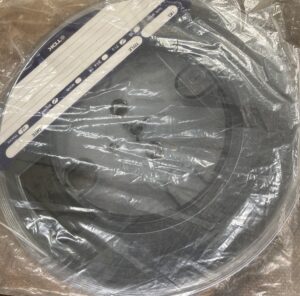
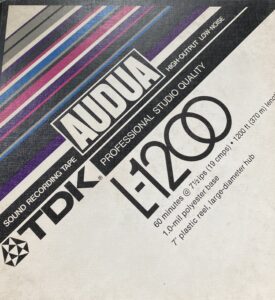
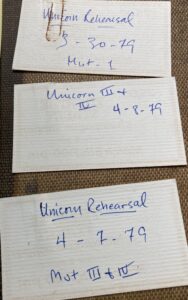
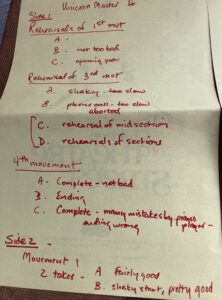
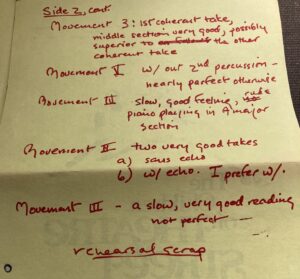
On April 30th, I wrote: “After Thursday’s disaster at dress rehearsal, I made the difficult decision to use the taped score. It was crushing to see how badly Mary took this news. All the players were crushed with the possible exception of Allison. I will see the Unicorn band one last time for a recording session on Friday. None of the players save Mary came to see the ballet once relieved of playing duties. I still have Alison’s checque and Ken’s as well.” The performance at the Penn Valley Community Theater was a shakedown cruise. The Hunt of the Unicorn was then launched at Jack Straws courtyard for the summer series. My journal records the occasions when Gallo and I went to see it, but not much is recorded about my response to it. Haskell had this to say in the Times:
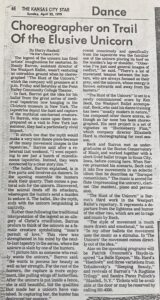
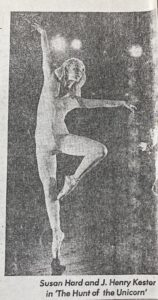
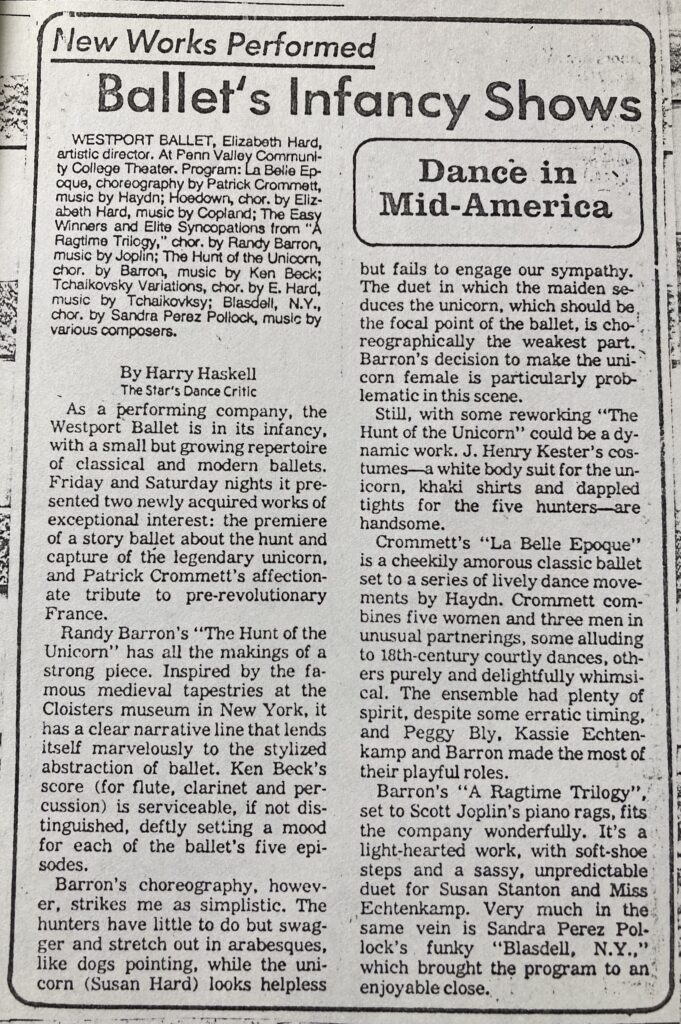
Haskell served in the most exalted role as critic. He spanked us; he spurred us on.
Fast forward to 1982/1983. My journaling fell off markedly. I had gotten even busier, I assume. I was touring with the Black Crack Review, playing a ragtime and barrelhouse gig, chasing assorted babes, and who knows what all else. I stopped writing it all down, letting months at a time go by between entries. On June 26th, 1983, I noted that The Hunt of the Unicorn was in progress at Jack Straws. This was the revision, undertaken prior to early April, 1983. I know this because a pair of file folders offer clues. One, a handful of photocopied pages of score, include the final page, dated April 8th, 1983. The other is marked “Unicorn 1983.” The second folder contains two pages, ink on cheap tear-off pad paper. The heading is “Unicorn Budget – Music.” I came up with a total figure of $1330.66. To arrive at that, I listed money paid for players: $380. Next, I tallied up my time spent composing: 75 hours. Is this accurate? I set my hourly rate at $10 an hour. (Still working cheap, Mr. Beck?) I also billed at the same rate for preparing the score and parts, 4 days, 5 hours per day. Then there were expenses: pens, paper, x-acto knife (?), glue sticks (?), photocopies, 3 copies of score from K. C. Blueprint Co… total: $89.78. The final category in this expense accounting is for the recording. I had someone else to do it, and I remember it happening at 301 East 43rd St. Did that person do it for the cost of the tape? Because that’s the only expense listed: 1/2 inch NAB spool of Ampex, $25. Maxell EE, $15.88. I billed for a music director’s fee of $250.
What was I doing this for? I had reached the limits of working for peanuts. I seem to have had a melt down. Of course, the Westport Ballet, ie., Elizabeth Hard and Randy, the recipients of this foolish bit of grandstanding, had no money to give. I think the company basically lost its shirt paying for theaters, advertising, and etcetera. The Westport Ballet file includes a document written by Liz that begins, “this is the most difficult and painful letter I’ve ever had to write…” I made fun of it, as I recall, for a period. But reading it now, all of the old impossibilities of theater on a shoestring come rushing back.
Listening to the second version now, I think I did a credible job revising the piece. The revisions are considerable, especially where I felt they were warranted. Clearly, I was now thinking of this as mercenary work for which I was not being adequately compensated. I could have used an attitude adjustment, but none was forthcoming. I am on the cusp of a bit of wisdom: I have some third degree Burns playing at the edges of my consciousness, along the lines of “O, wad some Power the giftie gie us / To see oursels as others see us!” (If only we could see the riches we possess / We might do more to wish for less.) “It wad frae monie a blunder free us / An’ foolish notion.”
While passing out clichés, a picture might be worth a few more words:
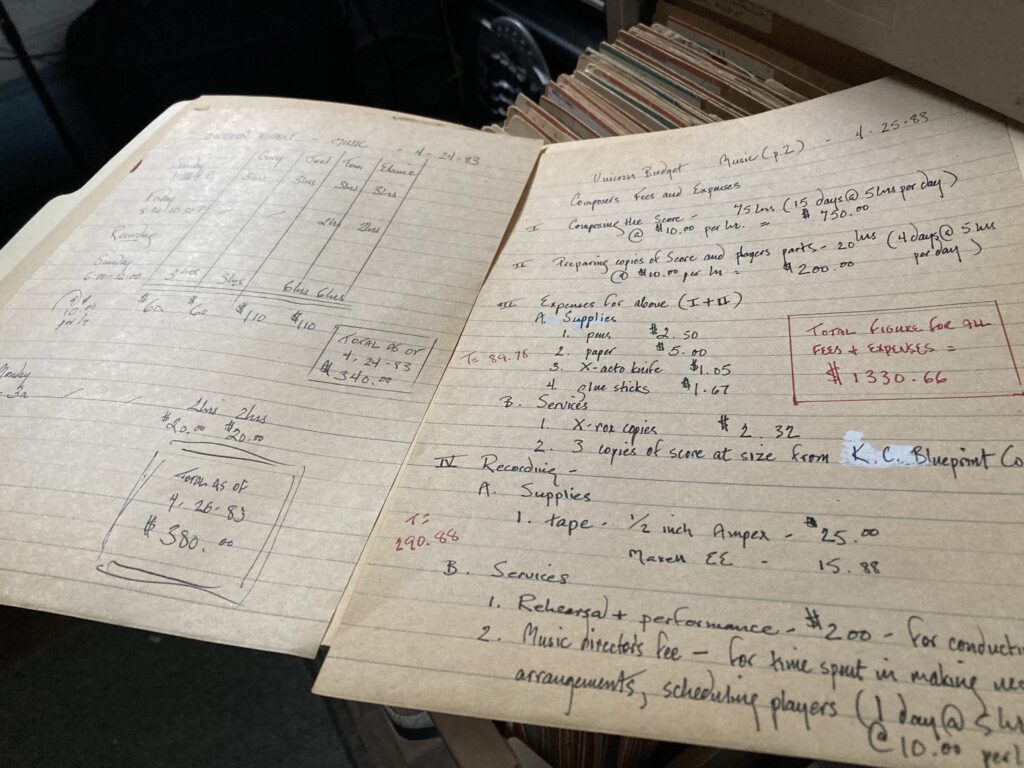
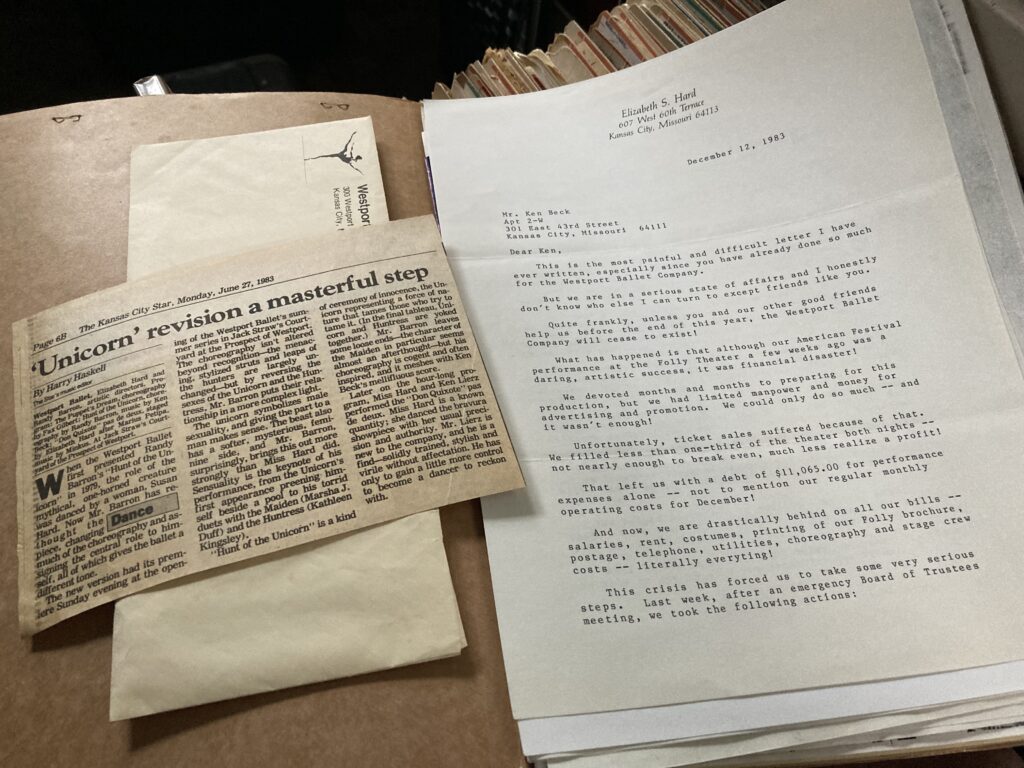
As promised, I’ve been batting this past history around with Randy Barron. The old “two brain” thing is as effective as it never was. Also, time has come back around, or perhaps caught back up, depending on one’s understanding of “time,” with the concepts expressed by the tale of the hunt and capture of a unicorn. Overarching all is the idea that it is a ‘tale.’ The unicorn is a mythological animal. Mythology necessarily inhabits an alternative reality. It is an instructive ‘conspiracy theory,’ aimed at moral instruction and entertainment. Any modern, contemporary mind can comprehend this idea. If one begins to believe in the actuality of unicorns, or Santa Clause, or the Easter Bunny, or even Bugs Bunny, one has either lost it or, depending on one’s bubble, found it. These days, we’re not mickey mousing around with this stuff.
The tale of the Unicorn involves at a minimum an animal with magical properties. Haskell’s review of the 1979 version noted the choice to make the unicorn female. It seems to have bothered Harry that the female unicorn was captured by seduction by another (human) female. In the 1983 version, Randy himself danced the part of the unicorn, and now it identified as male. In his review, Haskell notes that Barron, in reversing the gender of the unicorn and its hunter, he raises the complexity quotient. I never quite saw it that way, and still don’t. I didn’t think much of the gender issue at the time. I was surprised by Harry’s remarks about it. It didn’t seem germane to the tale. A magical beast is hunted by humans. It cannot be taken by force; it can only be taken by seduction. If gender is not irrelevant to the tale, then the unicorn is gender fluid. Gender fluidity is the human condition, and it is unfortunate that we’ve gotten so hung up on that nowadays.
In looking more carefully at the details of the tapestries, the facial expressions now seem to me quite telling. Here’s the aftermath of the capture:
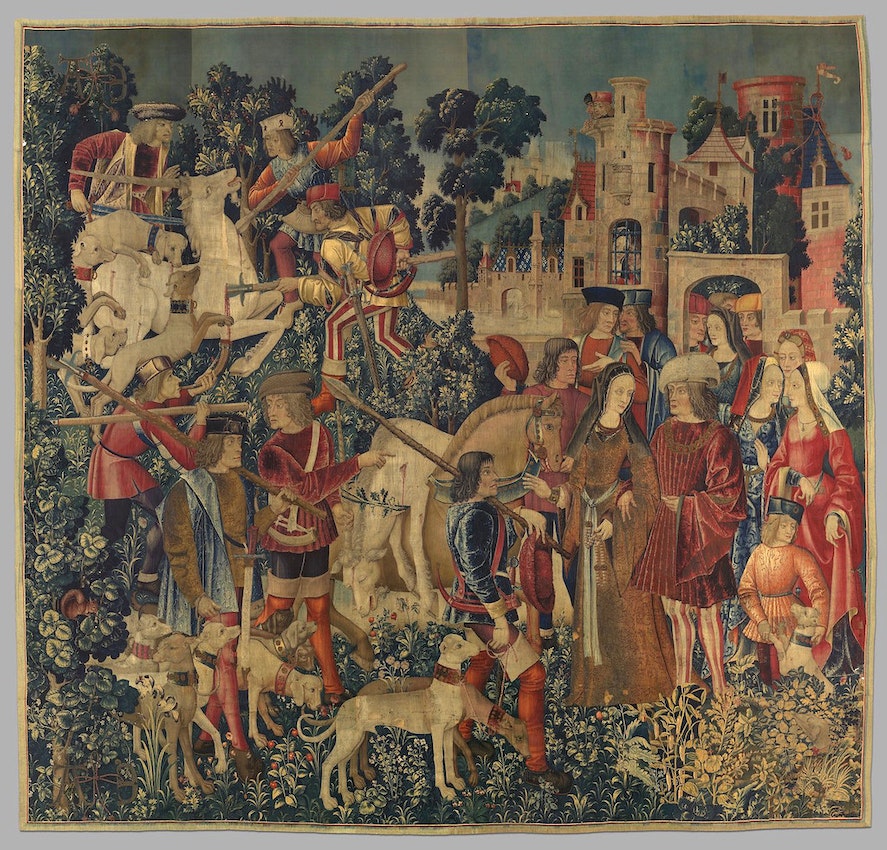
No one in this scene is ecstatic about the result of the hunt. Most look pretty dour, if not “concerned.” There are at least two scenes depicted in this one busy piece of art: to the left, the moment of the kill, to the right, the body draped over a hunters horse. It could be thought of as an illustration of the tellings as they emerge from the mouths of the hunters. It does not matter to the artist, or is part of the concept, that the narrative is not linear. One sees the various times and reactions all at once. By our standards, the lack of perspective, the fluid vanishing point, gives the whole work an unreal aura. It is the perfect depiction, it seems to me, of a very current mode of thinking: one imagines a reality, and not everyone forms the same consensus.
These are things I notice now. They are things I missed at the time I composed these pieces. I’m not sure these insights would have significantly changed my approach. I am proud of having captured the medieval atmosphere, particularly in the 1983 rewrite. I leave my reader with a few more images from the 1983 Jack Straws performances, courtesy of the choreographer…
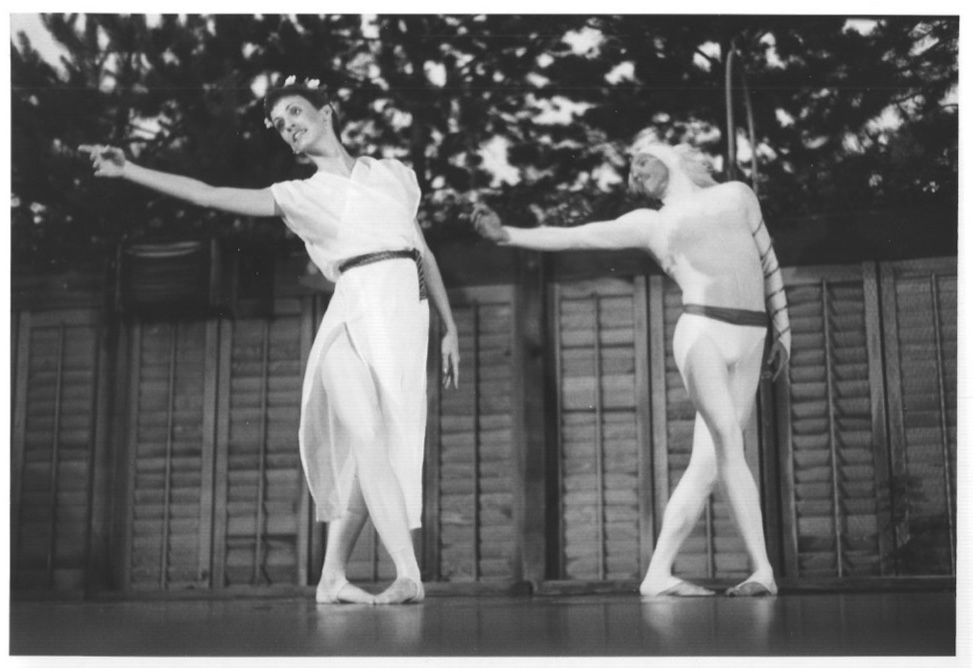
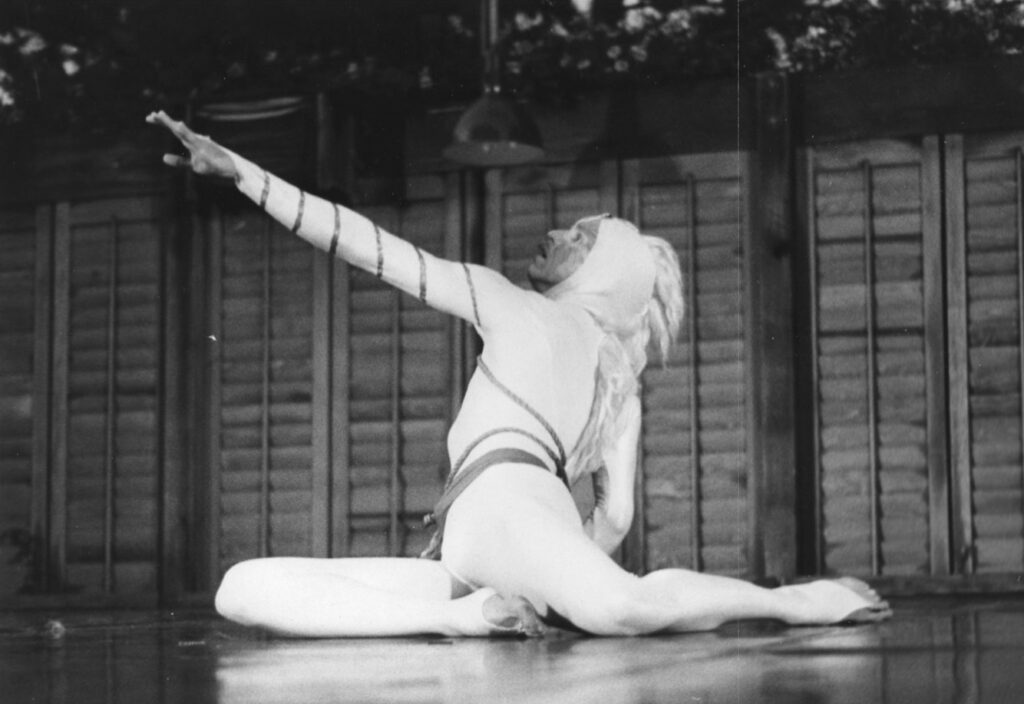
Lastly, as an epilogue, the few xeroxed copies of the score that survived in a folder. I assume the master copy is around here somewhere.
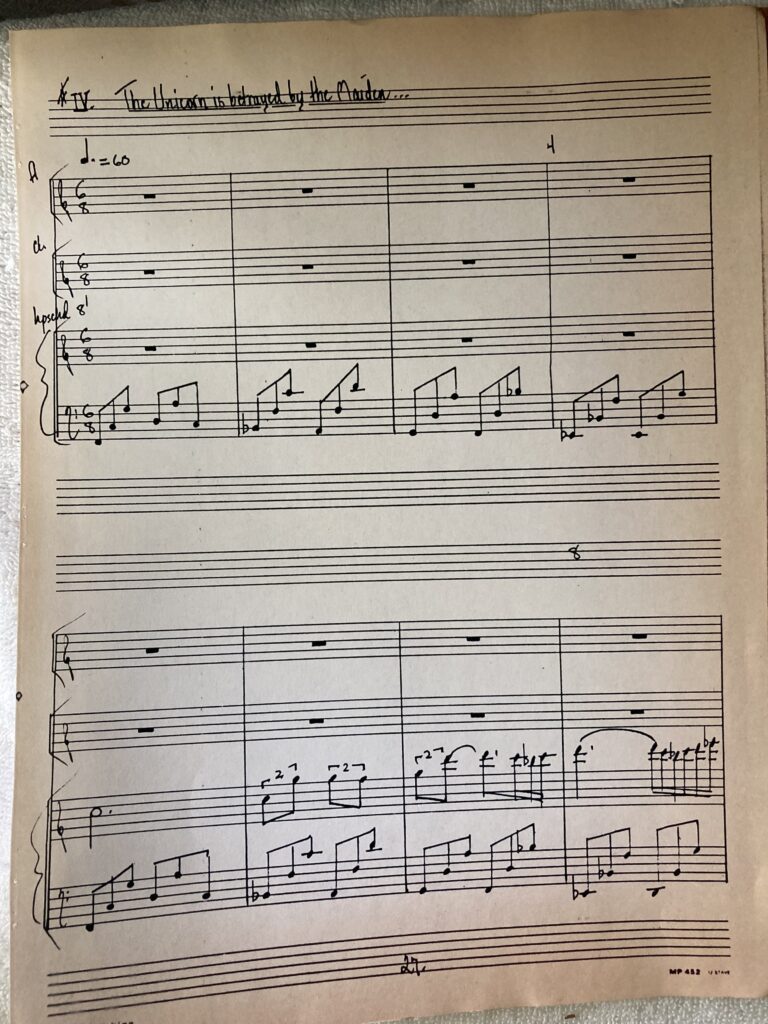
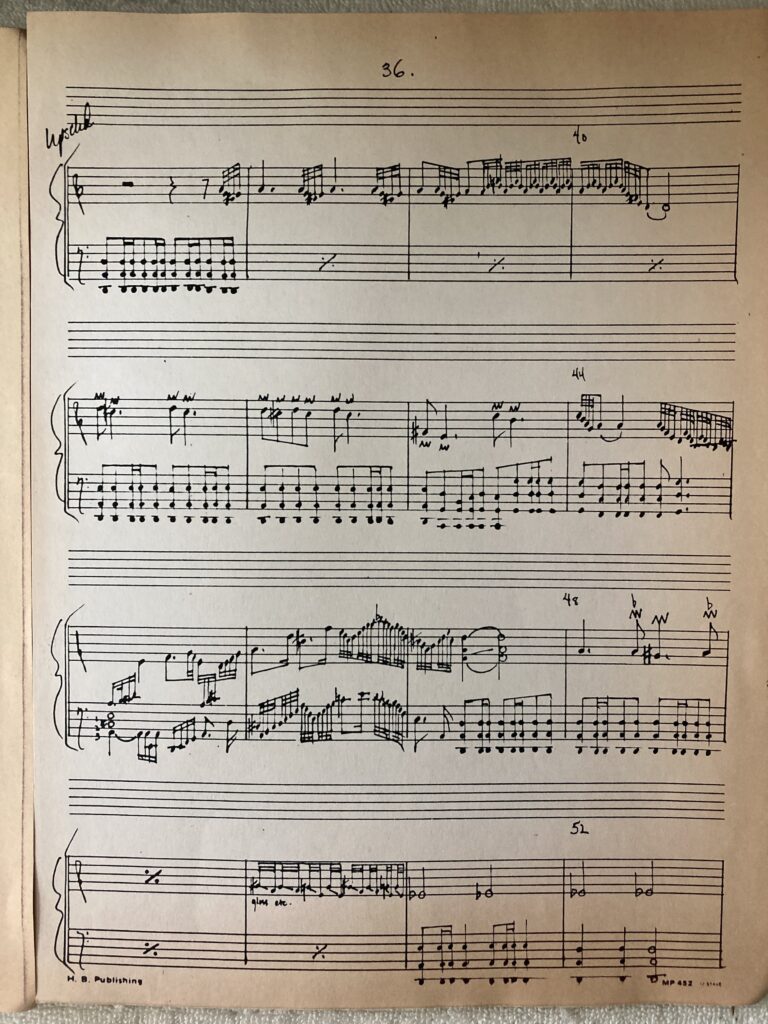
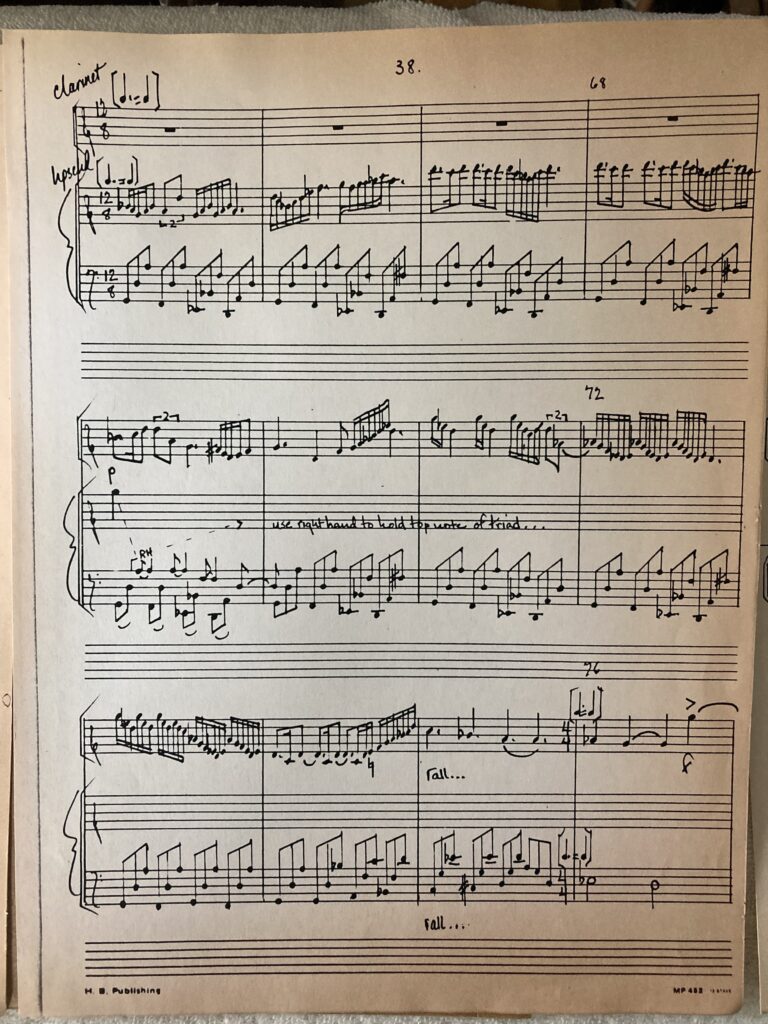
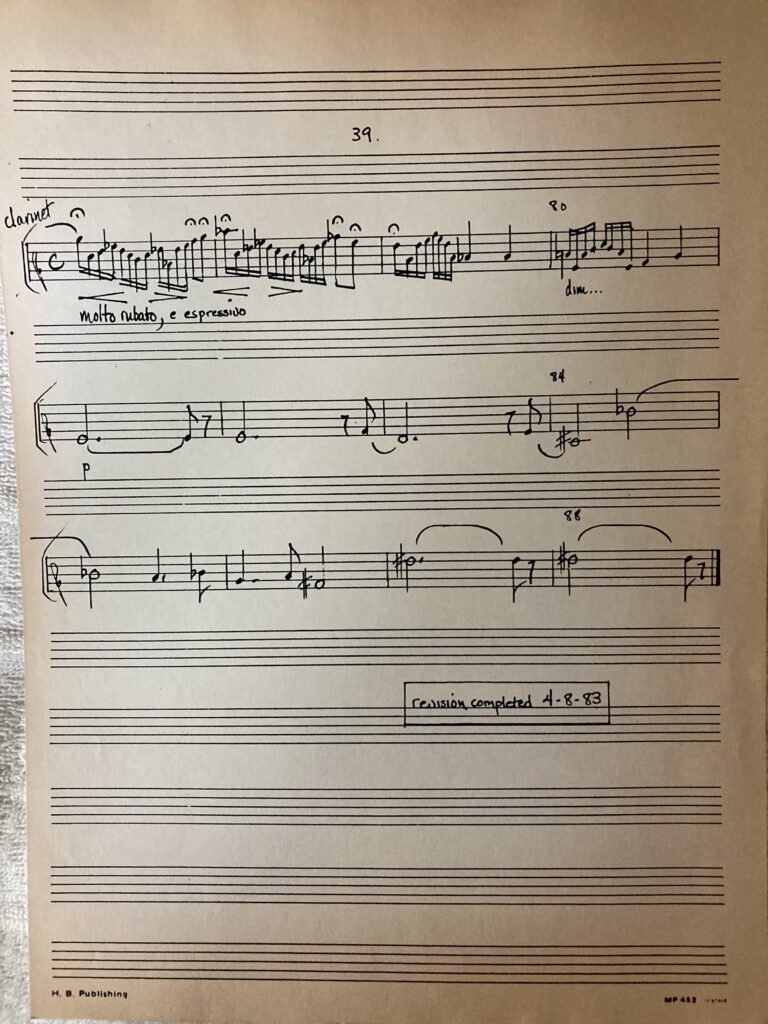
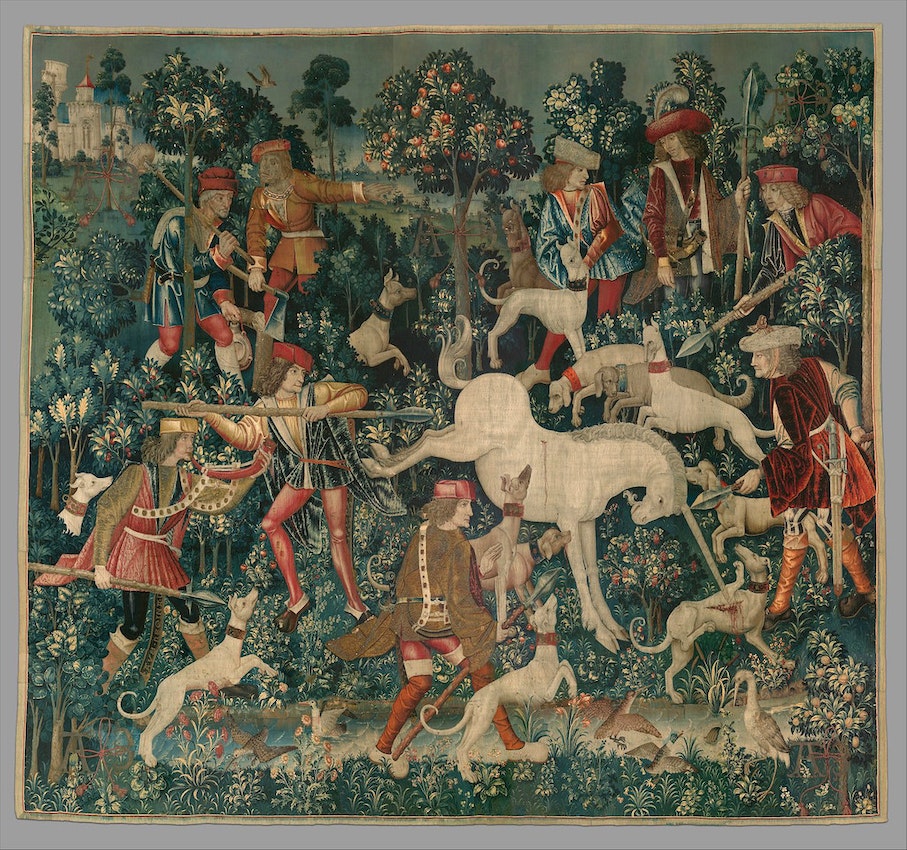
I have long felt like I didn’t do justice to the music in the various iterations of the dance that I created, but I must admit that the “Ballet’s Infancy Shows” review by the esteemed Harry Haskell is the one that has stuck in my mind. Not because it was in any way unfair, but because it was an accurate evaluation of that first draft choreography.
I was trying for something Nijinsky-like, a cross between Afternoon on the Phone (as we used to call it) and Rite of Spring, in that first iteration. But I didn’t know how to make the dancing both primal and aesthetically pleasing.
It was Haskell’s review that prompted me to re-think the relationship between the hunted and the hunter, and that led me to take the choreography into deeper terrain that I couldn’t see at first.
That first production of the unicorn ballet took place during the days of print newspapers, weekend reviews, and early morning visits to the Kansas City Star’s plant to get a freshly-printed copy of the Sunday paper.
Sometimes you made it to the car in the dark to read the review by the dome light. Sometimes you just went outside, found the Arts section, plopped the rest of the paper down and read the review by streetlight.
So the sinking feeling I got from that headline, and the spot-on suggestions from Haskell, resulted in a far better product than I remember, it seems.
Zooming in on that second review, I experienced simultaneously a thrill of recognition that I was on a good path with the dance (and that it did your music far more justice, Mr. Ken), as well as the wry understanding that this should have been my mental benchmark for the success of the piece. Not the awkwardness I felt in creating the first version, but the idea that it was a dance worth making, and worth making better.
Thanks for taking me down this road, Dr. ;-}
And above all, thanks for your always perceptive, generous, and inspired collaboration skills.